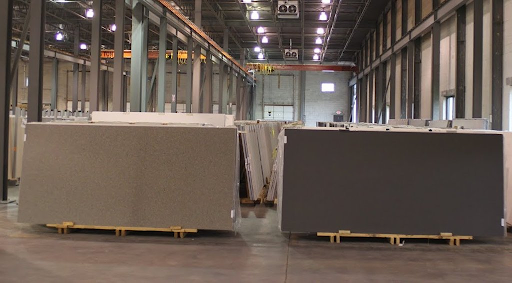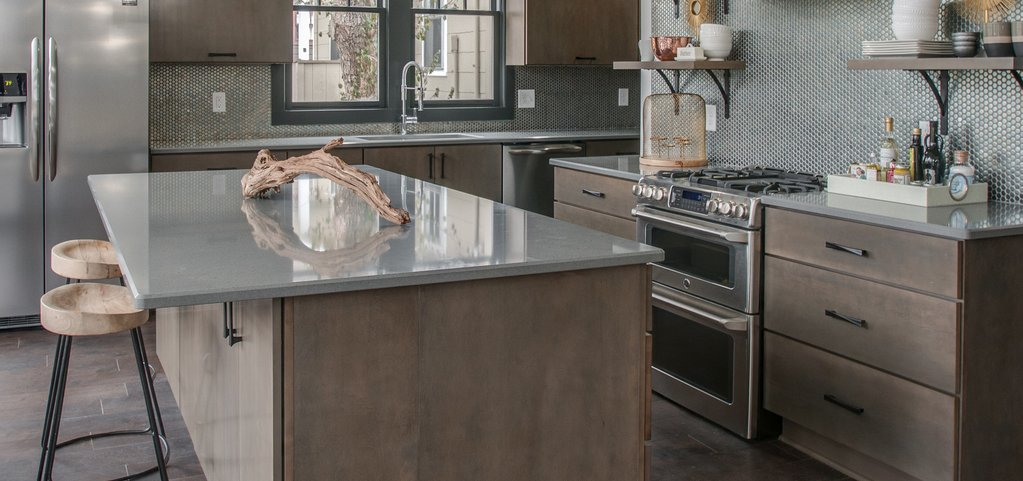Like many materials that you can purchase for your home, quartz countertops have a wide range of associated costs. Some options appear to be installed very inexpensively, while others cost significantly more. This can lead to confusion on the part of the homeowner, wondering if the quality of the quartz is an issue or if there are other factors that could be affecting the cost.
Understanding the Cost of Quartz Countertops
The truth is that like a lot of materials, the cost of quartz countertops are made up of numerous factors and conditions. Your countertop is unique, just like your house is, and for that reason, the final costs of your project may vary widely with the choices that you make.
Material Costs
The material portion of your new quartz countertops makes up about 30% of the total cost. So, if your new counter were to cost exactly $1,000, $300 of that is just the material or the slab itself.
You’ll notice if you visit a showroom or stone yard to view quartz slabs there are varying prices or price ranges from slab to slab. There are several factors that determine the price of a slab.
- Raw material – The pigments, resins, and the quartz itself that make up each slab vary in cost.
- Pattern – Complex vein patterns look very impressive, but they also cost more to produce than a simpler pattern.
- Manufacturing – How your slab is made, and how complex the pattern is will impact the cost.
- Thickness – Quartz slabs come in two thicknesses – 2cm and 3cm. A 3cm slab uses more material therefore costs more.
- Color – The overall color of the slab will also affect the cost. Whites cost more than darker colors
- Grain Pattern – The finer the grain, the more the slab will cost.
Fabrication and Installation

The rest of the cost of your countertop – 70% - is made up of the fabrication and installation of the material. Fabrication refers to how the slab is cut, shaped, and finished to match your specifications. Each slab will be cut to fit your specific kitchen.
- Equipment – The equipment that’s needed to cut and finish the slab is an investment for the fabricator, which will directly impact the cost of the finished slab.
- Skilled labor – The people running the equipment are highly trained and skilled employees, who need to be compensated for the work they are performing.
- Size of the Job – The larger the countertop you need for your kitchen, the higher the cost will be.
- Radius and curved cuts – A curved end to an island or peninsula makes a big impact on your design, but also takes more time and skill to cut
- Cutouts – Countertops often require a cutout for a sink or cooktop.
- Angles and layout – Every time your countertop makes a right angle, two pieces of slab will need to meet one another to make that turn. Those pieces must join up perfectly to give you the most seamless look. Making an angled cut gives you the best appearance but can be difficult and costly to do.
- Overhang – If you are overhanging your counter off an island or peninsula to sit at, it will add to the cost. This is due to both increasing the square footage required, and for the need of support, such as with special corbels to hold it in place, which will be installed at the same time as the counter.
- Backsplash – Not every countertop will have a matching backsplash, but this is an option. A 3-inch or 4-inch backsplash can give a cohesive look to the kitchen, and this extra material and fabrication will add to the cost.
- Upper Bar – Sometimes an island or peninsula will have an upper bar area, where you have a supported upper counter above the main counter. This can increase the function of your kitchen, but this extra slab will need careful positioning and support, which will increase manufacturing and installation costs.
- Type of appliances – Not all of your appliances will impact your counter, but some will. A drop-in cooktop, for example, will require a special cutout, while an appliance lift will require a special cut.
- Special edges – The most common edge given to a slab counter is the eased edge, but it isn’t the only one available. If you want a decorative edge such as a DuPont or Ogee, you will pay a premium for it
- Staging – How easy or hard the countertop is to access, what shape the cabinets are in, whether or not they need to dispose of an old counter – all of this will impact the installation cost.
- Number of stairs – If your kitchen is on the upper story of a home or requires the installers to climb numerous stairs while carrying the heavy slab, this will add to the cost of installation.
- Surrounding area – Slabs are large and heavy, and the resins and glues used to install them may damage surrounding surfaces. Special care needs to be taken to ensure that your home is left in great condition. Any extra steps the installers may need to do could impact the cost.
- Number of seams – Each time two pieces of slab need to join one another, they form a seam that must be sealed with a color matched resin. More seams mean more costs.
Know What You’re Investing In

A new quartz countertop is an investment in your home. The associated costs may vary from job to job, but this just ensures that you’re getting the best material and service that the fabricators can offer you. Get to know the material and what goes into its manufacturing and installation to make a better, more informed decision about how you’ll make it work for your home.

